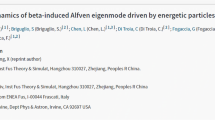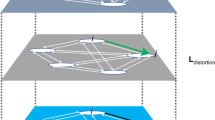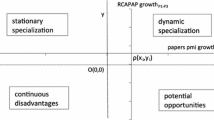Abstract
The capacity to attract citations from other disciplines — or knowledge export — has always been taken into account in evaluating the quality of scientific papers or journals. Some of the JCR’s (ISI’s Journal Citation Report) Subject Categories have a greater exporting character than others because they are less isolated. This influences the rank/JIF (ISI’s Journal Impact Factor) distribution of the category. While all the categories fit a negative power law fairly well, those with a greater External JIF give distributions with a more sharply defined peak and a longer tail — something like an iceberg. One also observes a major relationship between the rates of export and import of knowledge.
Similar content being viewed by others

References
Barabási, A.-L. (2002), Linked: The New Science of Networks. Cambridge, MA: Perseus Publishing.
Barabási, A.-L., Jeong, H., Neda, Z., Ravasz, E., Schubert, A., Vicsek, T. (2002). Evolution of the social network of scientific collaborations. Physica A, 311(3–4): 590–614.
Brooks, T. A. (1985), Private acts and public objects: an investigation of citer motivations. Journal of the American Society for Information Science, 36(4): 223–229.
Guerrero-Bote, V., Zapico-Alonso, F., Espinosa-Calvo, M. E., Gómez-Crisóstomo, R., Moya-Anegón, F. (2006). Binary Pathfinder: An improvement to the Pathfinder Algorithm. (in press).
Katz, J. S. (1999), The self-similar science system. Research Policy, 28: 501–517.
Katz, J. S. (2000), Scale independent indicators and research evaluation. Science & Public Policy, 27(1): 23–36.
Leydesdorff, L., Bensman, S. (2006), Classification and powerlaws: The logarithmic transformation. Journal of the American Society for Information Science and Technology (in press).
Merton, R. K. (1968), The Matthew Effect in science. Science, 159: 56–63.
Moya-Anegón, F., Vargas-Quesada, B., Herrero-Solana, V., Chinchilla Rodríguez, Z., Corera Álvarez, E., Muñoz Fernández, F. J. (2004), A new technique for building maps of large scientific domains based on the cocitation of classes and categories. Scientometrics, 61: 129–145.
Moya-Anegón, F., Chinchilla Rodríguez, Z., Corera Álvarez, E., Herrero-Solana, V., Muñoz Fernández, F. J., Vargas-Quesada, B. (2005), Indicadores bibliométricos de la actividad científica española-2004. FECYT: Madrid.
Pichappan, P. (1995), A dual refinement of journal self-citation measures. Scientometrics, 33(2): 13–21.
Pinski, G., Narin, F. (1976), Citation influence for journal aggregates of scientific publications: Theory, with application to the literature of physics. Information Processing and Management, 12: 297–312.
Podlubny, I. (2005), Comparison of scientific impact expressed by the number of citations in different fields of science. Scientometrics, 64(1): 95–99.
Pudovkin, A., Garfield, E. (2002), Algorithmic procedure for finding semantically related journals. Journal of the American Society for Information Science and Technology, 53(13): 1113–1119.
Schvaneveldt, R. W., Dearholt, D. W., Durso, F. T. (1988), Graph theoretic foundations of Pathfinder networks. Computers & Mathematics with Applications, 15(4): 337–345.
Sombatsompop, N., Markpin, T. (2005), Making an equality of ISI impact factors for different subject fields. Journal of the American Society for Information Science and Technology, 56(7): 676–683.
Stegmann, J., Grohmann G. (2001), Citation rates, knowledge export and international visibility of dermatology journals listed and not listed in the Journal Citation Reports. Scientometrics, 50(3): 483–502.
Van Leeuwen, T. N., Moed, H. F. (2002), Development and application of journal impact measures in the Dutch science system. Scientometrics, 53(2): 249–266.
Van Leeuwen, T. N., Visser, M. S., Moed, H. F., Nederhof, T. J., Van Raan, A. F. J. (2003), The Holy Grail of science policy: Exploring and combining bibliometric tools in search of scientific excellence. Scientometrics, 57(2): 257–280.
Wagner, C. S., Leydesdorff, L. (2006), Network Structure, Self-organization and the Growth of International Collaboration in Science Research Policy (in press).
Wormell, I. (1998), Informetric analysis of the international impact of scientific journals: How ‘international’ are the international journals? Journal of Documentation, 54(5): 584–605.
Author information
Authors and Affiliations
Corresponding author
Rights and permissions
About this article
Cite this article
Guerrero-Bote, V.P., Zapico-Alonso, F., Espinosa-Calvo, M.E. et al. Import-export of knowledge between scientific subject categories: The iceberg hypothesis. Scientometrics 71, 423–441 (2007). https://doi.org/10.1007/s11192-007-1682-3
Received:
Issue Date:
DOI: https://doi.org/10.1007/s11192-007-1682-3



